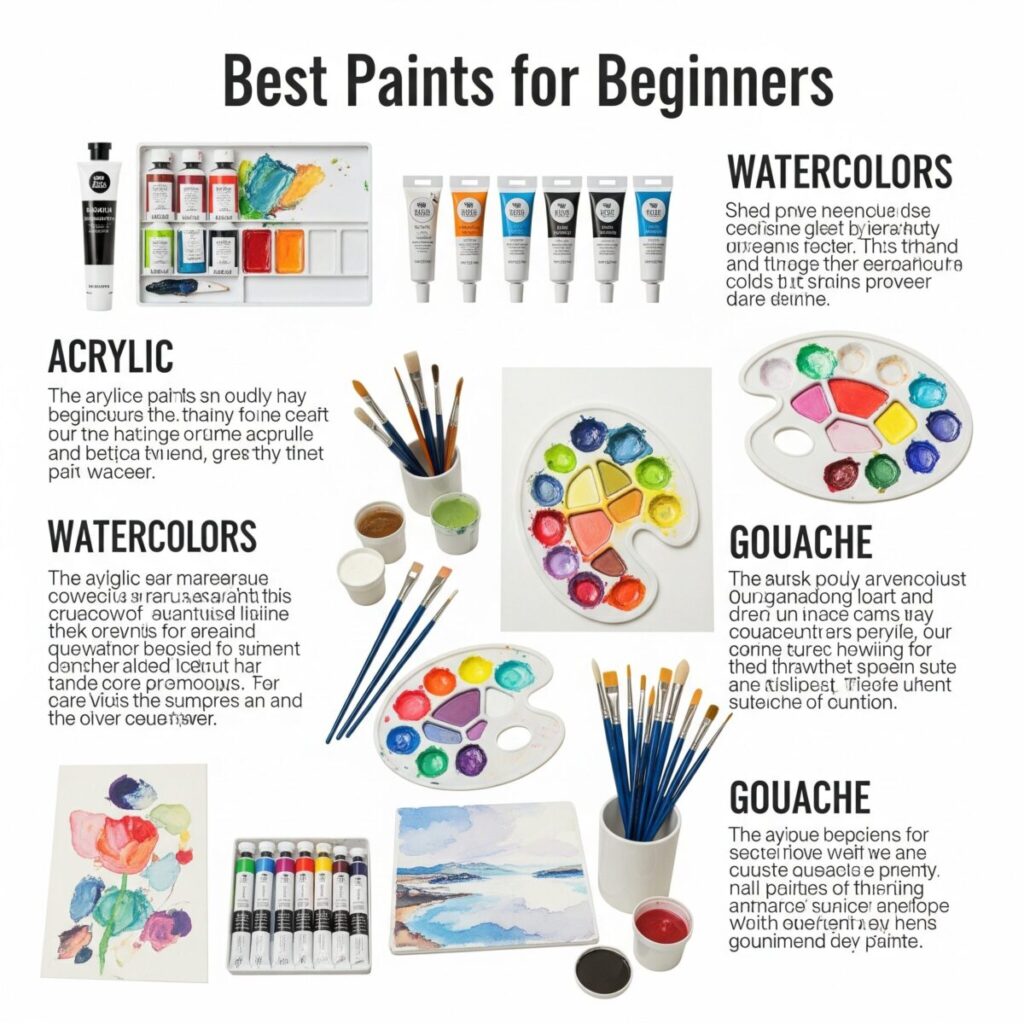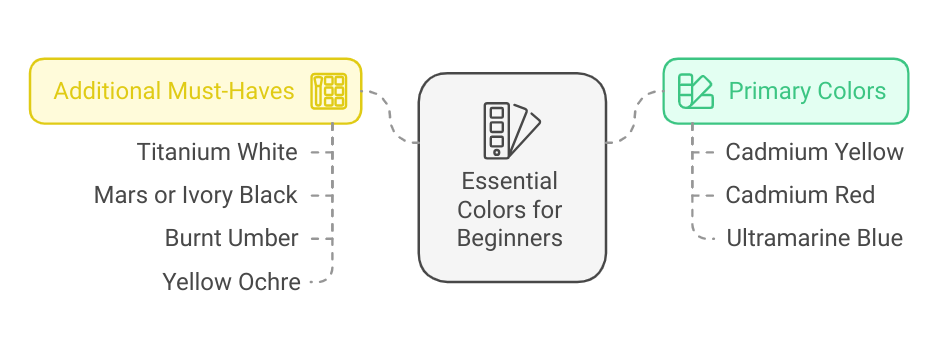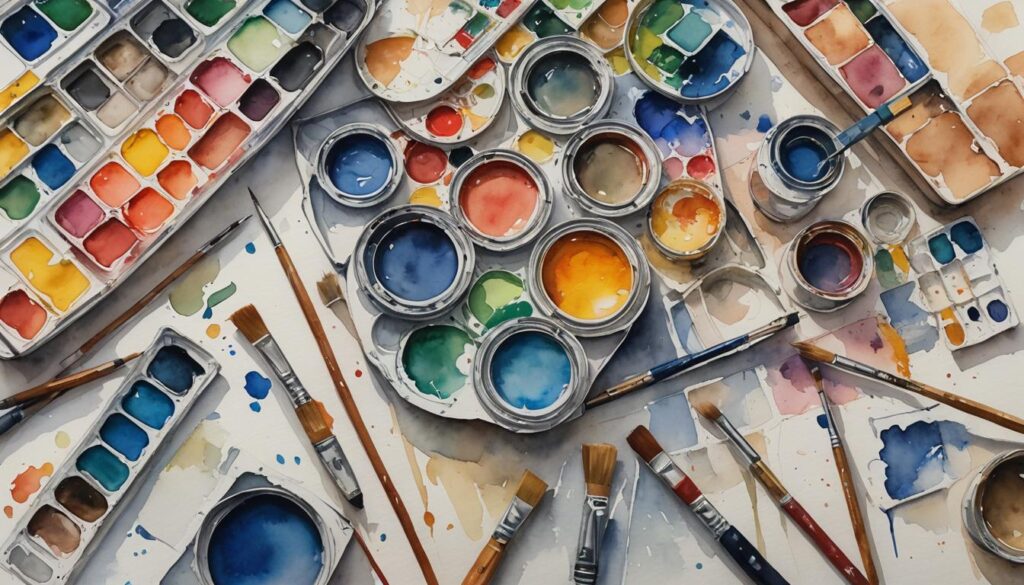Starting your artistic journey is exciting, but picking the best paints for beginners can feel overwhelming with so many options available. Don’t worry – this guide will help you choose the perfect paints to kick off your creative adventure.
Key Points
- Acrylics are the Best for Beginners: If you’re just starting, acrylic paints are your best friend. They are versatile, dry quickly, and are easy to clean up with just soap and water. You can use them for various techniques, from thin washes like watercolor to thick, textured applications like oil paints. 🎨
- Watercolor for a Fluid Style: For those who love a more delicate and translucent look, watercolor paints are a great choice. They are portable and require minimal supplies, but they can be a bit challenging to control due to their fluid nature.
- Oils for the Patient Painter: Oil paints offer rich, vibrant colors and a long drying time, which is perfect for blending and making changes to your work. However, they require special solvents for cleanup and a well-ventilated space to work in.
- Student vs. Professional Grade: As a beginner, it’s best to start with student-grade paints. They are more affordable and offer good quality for learning the fundamentals of color mixing and painting techniques. You can always upgrade to professional-grade paints as your skills develop.
- Start with a Limited Palette: Don’t go out and buy every color you can find! A basic set of primary colors (red, yellow, blue), plus black and white, is all you need to get started. This will help you learn the art of color mixing and create a wide range of hues.

Why Paint Selection Matters for Beginners
Just like learning to drive in a car that feels comfortable to you, starting with the right paints can make your artistic journey much smoother. The best paints for beginners offer a balance of quality, ease of use, and affordability. When you have materials that work well, you can focus on learning techniques instead of fighting with your supplies – always choose the best art supplies you can afford. To understand more about the pigments read – read Science of Pigments
Types of Paint for Beginners
Acrylic Paints: The Perfect Starting Point
Acrylic paints are often considered the best paints for beginners, and for good reason. They’re like the Swiss Army knife of the art world – versatile, forgiving, and easy to use. Here’s why they’re great for starting out:
- Water-soluble when wet, but permanent when dry
- Quick drying time, which means fewer smudges
- Easy to clean up with just soap and water
- Work well on many different surfaces
- More affordable than oils
- Can be used thick like oils or thin like watercolors
Watercolors: For the Patient Beginner
While slightly more challenging to master, student-grade watercolors can be an excellent choice for beginners who enjoy a more fluid style:
- Portable and easy to set up
- Great for learning color mixing
- Perfect for sketching and journaling
- Less expensive to start with than other media
- Easy to create light, airy effects
Oil Paints: The Traditional Choice
Though traditionally seen as advanced, many beginners can start with oils if they’re patient:
- Slow drying time allows for lots of adjustments
- Rich, vibrant colors
- Great for learning color blending
- More forgiving for mistakes than watercolors
Best Paint Brands for Beginners

Acrylic Paint Recommendations
Liquitex Basics
- Excellent quality for the price
- Good color selection
- Consistent texture
- Around $25-30 for a starter set
Artist’s Loft Fundamentals
- Budget-friendly option
- Available at most craft stores
- Good for practicing techniques
- Usually under $20 for a set
Golden Open Acrylics
- Higher-end option
- Longer working time
- Professional quality
- Investment piece at $40-50 per set
Watercolor Recommendations
Winsor & Newton Cotman
- Student grade but excellent quality
- Great color mixing properties
- Available in convenient sets
- Around $25-35 for a starter set
Sakura Koi
- Perfect for beginners
- Portable sets available
- Vibrant colors
- Approximately $20-30 for a basic set
Essential Colors for Beginners

When starting out, you don’t need every color in the rainbow. Here’s your essential palette:
Primary Colors:
- Cadmium Yellow
- Cadmium Red
- Ultramarine Blue
Additional Must-Haves:
- Titanium White
- Mars or Ivory Black
- Burnt Umber
- Yellow Ochre
With these colors, you can mix most of the shades you’ll need while learning color theory and mixing techniques.
Paint Quality Levels
Student Grade vs. Professional Grade
Think of paint grades like cooking ingredients:
- Student Grade = Good for learning and practicing
- Professional Grade = Like premium ingredients for special projects
Student grade paints are the best paints for beginners because they:
- Cost less than professional grades
- Offer good quality for learning
- Have simpler formulations
- Allow for plenty of practice
Tips for Getting Started
Start Small
- Buy smaller tubes or sets first
- Experiment with different brands
- Add colors gradually as you learn
Consider Your Projects
- Choose paints based on what you want to create
- Think about where you’ll be painting
- Consider drying time needs
Storage and Care
- Keep paints at room temperature
- Store away from direct sunlight
- Close caps tightly after use
- Clean brushes thoroughly
Common Beginner Mistakes to Avoid
- Buying too many colors at once
- Choosing the cheapest possible paints
- Skipping student grade and going straight to professional
- Not reading product labels for lightfastness and permanence
When to Upgrade Your Paints
You’ll know it’s time to try professional grade paints when:
- You’re comfortable with basic techniques
- You find yourself limited by student grade properties
- You’re creating artwork you want to sell
- You notice specific qualities you’d like in your paints
Investment Tips
Plan to spend about:
- $30-50 for a good beginner acrylic set
- $25-40 for a starter watercolor set
- $50-70 for a basic oil paint set
Remember: It’s better to have a few quality paints than many low-quality ones.
Conclusion
Choosing the best paints for beginners doesn’t have to be complicated. Start with student-grade acrylics or watercolors, focus on essential colors, and upgrade as your skills develop. Remember that every artist started as a beginner, and your choice of paints should support your learning journey, not hinder it.
The most important thing is to start creating – your perfect paint collection will grow naturally as you develop your skills and discover your artistic style. Happy painting!
FAQs: Best Paints for Beginners
What is the best type of paint for beginners?
For most beginners, acrylic paint is the best choice. It’s affordable, easy to use, and incredibly versatile. You can paint on a variety of surfaces, from canvas and paper to wood and fabric. Plus, it dries quickly and cleans up with water, making it a low-mess option for those new to painting.
What is the difference between acrylic and watercolor paint?
The main difference between acrylic and watercolor paint is their transparency and how they are used. Acrylic paint is opaque and can be layered to cover up mistakes. It’s water-based but becomes water-resistant when dry. Watercolor paint, on the other hand, is transparent and works by letting the white of the paper show through. It can be reactivated with water even after it has dried.
Is oil or acrylic paint better for beginners?
While both oil and acrylic paints have their advantages, acrylic paint is generally recommended for beginners. The main reasons are that acrylics are easier to clean up (with just water), dry much faster, and don’t require the use of harsh solvents, which are necessary for oil paints. Oils offer a longer working time, which can be beneficial, but the cleanup and ventilation requirements can be a challenge for those just starting.
What is gouache paint and is it good for beginners?
Gouache is an opaque watercolor paint. It has a matte finish and can be a lot of fun to work with, but it can be a little tricky for beginners because it dries to a different value than it appears when wet. However, its a great option for those who want the opaque look of acrylics with the water-solubility of watercolors.
How many paint colors do I need to start with?
You don’t need a huge set of colors to get started. A basic set of primary colors (a warm and cool version of each: red, yellow, and blue), plus titanium white and mars black, will allow you to mix a wide range of colors. This is a great way to learn about color theory and save money when you’re just starting.


